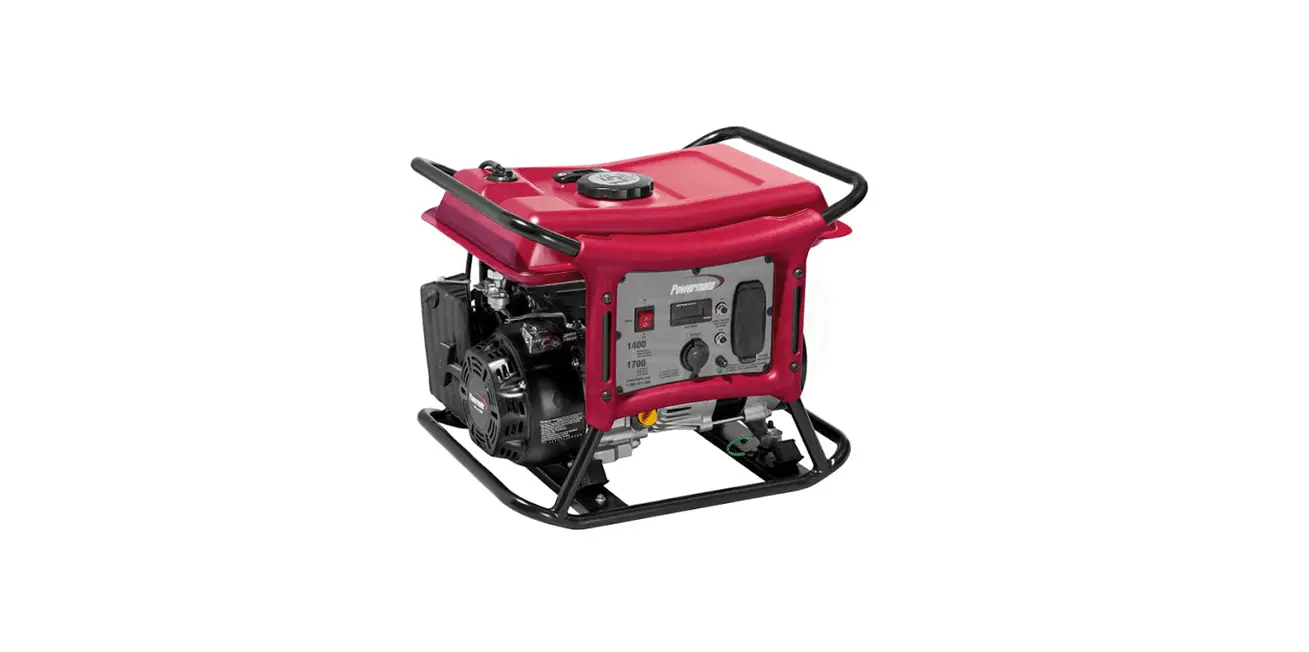Colman Powermate

Colman Powermate
Portable Generator
Powermate CX1400/3500/5500
MODEL:____________
SERIAL:____________
DATE PURCHASED:_____________________________
This product is not intended to be used in a critical life support application. Failure to adhere to this warning could result in death or serious injury.
Register your Powermate product at:
www.powermate.com
1-800-445-1805
SAVE THIS MANUAL FOR FUTURE REFERENCE
WARNING : California Proposition 65. Engine exhaust and some of its constituents are known to the state of California to cause cancer, birth defects, and other reproductive harm.
WARNING : California Proposition 65. This product contains or emits chemicals known to the state of California to cause cancer, birth defects, and other reproductive harm.
Section-1. Introduction and Safety
Introduction
Thank you for purchasing a Powermate product. This unit has been designed to provide high-performance, efficient operation, and years of use when maintained properly.
WARNING : Consult Manual. Read and understand manual completely before using product. Failure to completely understand manual and product could result in death or serious injury
If any section of the manual is not understood, contact your nearest Independent Authorized Service Dealer (IASD), or contact Powermate Customer Service at 1-800-445-1805, or www.powermate.com with any questions or concerns.
The owner is responsible for proper maintenance and safe use of the equipment. Before operating, servicing or storing this generator:
- Study all warnings in this manual and on the product carefully.
- Become familiar with this manual and the unit before use.
- Refer to the Assembly section of the manual for instructions on final assembly procedures. Follow the instructions completely. Save these instructions for future reference. ALWAYS supply this manual to any individual that will use this machine.
THE INFORMATION CONTAINED HEREIN WAS BASED ON MACHINES IN PRODUCTION AT THE TIME OF PUBLICATION. POWERMATE RESERVES THE RIGHT TO MODIFY THIS MANUAL AT ANY TIME.
Safety Rules
The manufacturer cannot anticipate every possible circumstance that might involve a hazard. The warnings in this manual, and on tags and decals affixed to the unit are, therefore, not all inclusive. If using a procedure, work method or operating technique that the manufacturer does not specifically recommend, verify that it is safe for others. Also make sure the procedure, work method or operating technique utilized does not render the equipment unsafe. Throughout this publication, and on tags and decals affixed to the generator, DANGER, WARNING, CAUTION and NOTE blocks are used to alert personnel to special instructions about a particular operation that may be hazardous if performed incorrectly or carelessly. Observe them carefully. Their definitions are as follows:
DANGER : Indicates a hazardous situation which, if not avoided, will result in death or serious injury.
WARNING : Indicates a hazardous situation which, if not avoided, could result in death or serious injury
CAUTION : Indicates a hazardous situation which, if not avoided, could result in minor or moderate injury.
NOTE: Notes contain additional information important to a procedure and will be found within the regular text of this manual. These safety warnings cannot eliminate the hazards that they indicate. Common sense and strict compliance with the special instructions while performing the action or service are essential to preventing accidents.
Safety Symbols and Meanings

DANGER : Asphyxiation. Running engines produce carbon monoxide, a colorless, odorless, poisonous gas. Carbon monoxide, if not avoided, will result in death or serious injury.
- If you start to feel sick, dizzy, or weak after the generator has been running, move to fresh air IMMEDIATELY. See a doctor, as you could have carbon monoxide poisoning.
DANGER

The exhaust system must be properly maintained. Do not alter or modify the exhaust system as to render it unsafe or make it noncompliant with local codes and/or standards. Failure to do so will result in death or serious injury.
DANGER

Electrocution. Water contact with a power source,
if not avoided, will result in death or serious injury.
DANGER

Electrocution. Turn utility and emergency power supplies to OFF before connecting power source and load lines. Failure to do so will result in death or serious injury.
WARNING
Equipment and property damage. Do not alter construction of, installation, or block ventilation for generator. Failure to do so could result in unsafe operation or damage to the generator.
WARNING

Asphyxiation. Always use a battery operated carbon monoxide alarm indoors and installed according to the manufacturer’s instructions. Failure to do so could result in death or serious injury.
WARNING
Equipment and property damage. Do not operate unit on uneven surfaces, or areas of excessive moisture, dirt, dust or corrosive vapors. Doing so could result in death, serious injury, property and equipment damage.
WARNING

Moving Parts. Keep clothing, hair, and appendages away from moving parts. Failure to do so could result in death or serious injury.
WARNING

Hot Surfaces. When operating machine, do not touch hot surfaces. Keep machine away from combustibles during use. Hot surfaces could result in severe burns or fire.
WARNING
Do not insert any object through the air cooling slots. Generator can start at any time and could result in death, serious injury, and unit damage.
WARNING
Risk of injury. Do not operate or service this machine if not fully alert. Fatigue can impair the ability to service this equipment and could result in death or serious injury.
WARNING
Injury and equipment damage. Do not use generator as a step. Doing so could result in falling, damaged parts, unsafe equipment operation, and could result in death or serious injury.
WARNING
Equipment damage. Do not attempt to start or operate a unit in need of repair or scheduled maintenance. Doing so could result in serious injury, death, or equipment failure or damage.
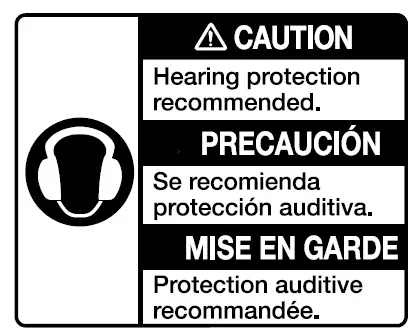
For safety reasons, it is recommended that the maintenance of this equipment be performed by an IASD. Inspect the generator regularly, and contact the nearest IASD for parts needing repair or replacement.
Section-2. General Information and Setup
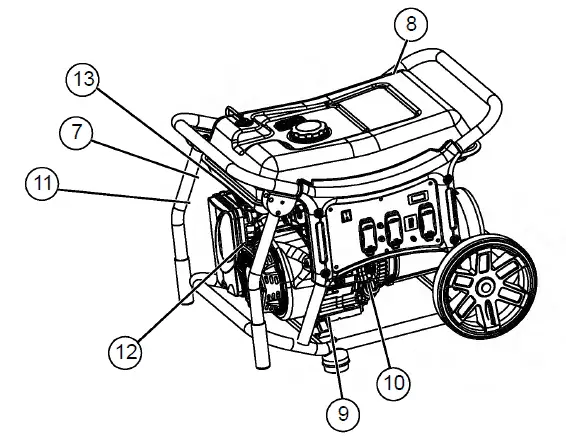
TABLE 1. Generator Components
- 120 Volt AC, 20 Amp Duplex Receptacle
- 120/240 Volt AC, 30 Amp Locking Receptacle (NEMA L14-30R)
- Circuit Breakers (AC)
- On/Off Switch
- Hour Meter
- Ground Terminal
- Choke Lever
- Fuel Tank
- Oil Drain
- Oil Fill
- Air Cleaner
- Recoil Handle
- Fuel Shutoff Valve
- Battery Charger
- Circuit Breaker (DC)
- 120 Volt AC, 30 Amp Locking Receptacle (NEMA L5-30R)
- 120 Volt AC, 30 Amp Receptacle (NEMA TT-30R)
- 2-pole Circuit Breaker (AC)
- 120 Volt AC, 20A GFCI Duplex Receptacle (CX5500 CARB only)
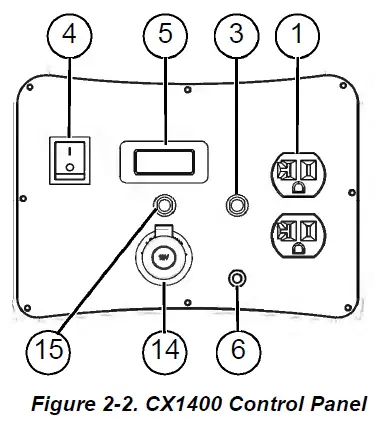

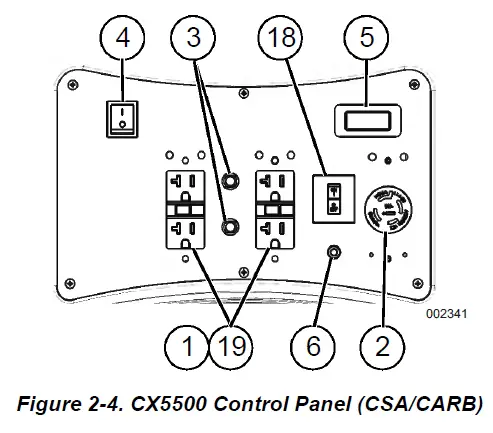
Know Your Generator
WARNING : Consult Manual. Read and understand manual completely before using product. Failure to completely understand manual and product could result in death or serious injury Replacement owner’s manuals are available at www.powermate.com.
Emissions
The United States Environmental Protection Agency (US EPA) (and California Air Resources Board (CARB), for engines/equipment certified to California standards) requires that this engine/equipment complies with exhaust and evaporative emissions standards. Locate the emissions compliance decal on the engine to determine applicable standards. For emissions warranty information, please reference the included emissions warranty. It is important to follow the maintenance specifications in the manual to ensure that the engine complies with the applicable emissions standards for the duration of the product’s life.
Product Specifications
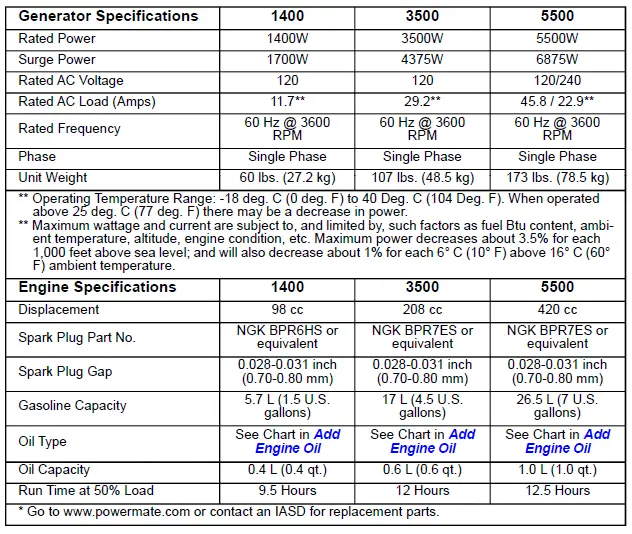
Connection Plugs
120 VAC, 20 Amp, Duplex Receptacle
The 120 Volt outlet is overload protected by a 20 Amp push-to-reset circuit breaker. See Figure 2-5. Each receptacle will power 120 Volt AC, single phase, 60 Hz electrical loads requiring up to 2400 watts (2.4 kW) or 20 Amps of current. Use only high quality, wellinsulated, 3-wire grounded cord sets rated for 125 Volts at 20 Amps (or greater).
NOTE: Limit length of extension cords to fifteen feet, or less, to prevent voltage drop and overheating of wires.
120 VAC, 20 Amp, GFCI Duplex Receptacle (if equipped)
The 120 Volt outlet is overload protected by a 20 Amp push-to-reset circuit breaker. See Figure 2-6. Each receptacle will power 120 Volt AC, single phase, 60 Hz electrical loads requiring up to 2400 watts (2.4 kW) or 20 Amps of current. Use only high quality, wellinsulated, 3-wire grounded cord sets rated for 125 Volts at 20 Amps (or greater). It also provides protection with a Ground Fault Circuit Interrupter with a press to TEST and RESET button.
NOTE: Limit length of extension cords to fifteen feet, or less, to prevent voltage drop and overheating of wires.
120 VAC, 30 Amp Receptacle
Use a NEMA TT-30R plug with this receptacle. Connect a suitable 3-wire cord set to the plug and to desired load. The cord set should be rated for 125 Volts AC at 30 Amps (or greater). See Figure 2-7.
Use this receptacle to operate 120 Volt AC, 60Hz, single phase loads requiring up to 3600 watts (3.6kW) of power at 30 Amps. The outlet is protected by a 30 Amp push-to-reset circuit breaker.
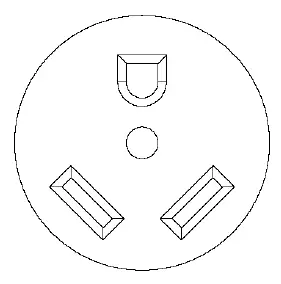
Figure 2-7. 120 VAC, 30 Amp Receptacle NEMA TT-30R
120/240 VAC, 30 Amp Receptacle
Use a NEMA L14-30 plug with this receptacle (rotate to lock/unlock). Connect a suitable 4- wire grounded cord set to plug and desired load. The cord set should be rated 250 Volts AC at 30 Amps (or greater). See Figure 2-8. Use this receptacle to operate 120 Volt AC, 60 Hz, single phase loads requiring up to 2760 Watts (2.7 kW) of power at 23 Amps or 240 Volt AC, 60 Hz, single phase loads requiring up to 5520 watts (5.5 kW) of power at 23 Amps. The outlet is protected by a 2-pole 23 Amp toggle switch circuit breaker.
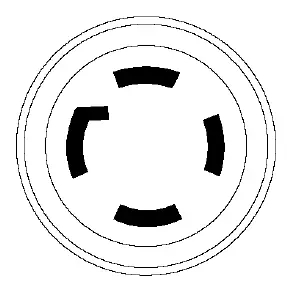
Figure 2-8. 120/240 VAC, 30 Amp Receptacle NEMA L14-30R
110/120 VAC, 30 Amp Receptacle
Use a NEMA L5-30 plug with this receptacle (rotate to lock/unlock). Connect a suitable 3- wire cord set to the plug and to desired load. The cord set should be rated for 125 Volts AC at 30 Amps (or greater). See Figure 2-9. Use this receptacle to operate 120 Volt AC, 60Hz, single phase loads requiring up to 3600 watts (3.6kW) of power at 30 Amps. The outlet is protected by a 30 Amp push-to-reset circuit breaker.
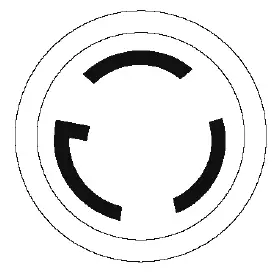
NEMA L5-30
Remove Contents from Carton
- Open carton completely by cutting each corner from top to bottom.
- Remove and verify carton contents prior to assembly. Carton contents should contain the following:
TABLE 2. Accessories

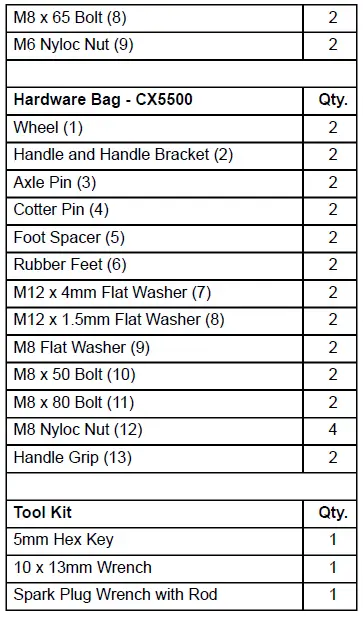
3. Call Powermate Customer Service 1-800- 445-1805 with the unit model and serial number for any missing carton contents.
4. Record model, serial number, and date of purchase on front cover of this manual.
Assembly
WARNING: Consult Manual. Read and understand manual completely before using product. Failure to completely understand manual and product could result in death or serious injury.
Call Powermate Customer Service at 1-800- 445-1805 for any assembly issues or concerns. Please have model and serial number available.
The following tools are required to install the accessory kit.
• See Table 2: Accessories (Tool Kit)
NOTE: The wheels are not intended for over the road use.
CX3500
Install wheels as follows:
- Slide axle pin (2) through wheel (1), M10 x 4mm flat washer (6), and frame.
- Insert cotter pin (3) through axle (2). Bend tabs (of cotter pins) outward to lock into place.
Install frame foot assembly as follows:
- Slide rubber foot (5), M6 nyloc nut (9), and foot spacer (4) onto M6 x 25 bolt (7).
- Align through holes in frame rail and secure with M8 x 65 bolt (8).
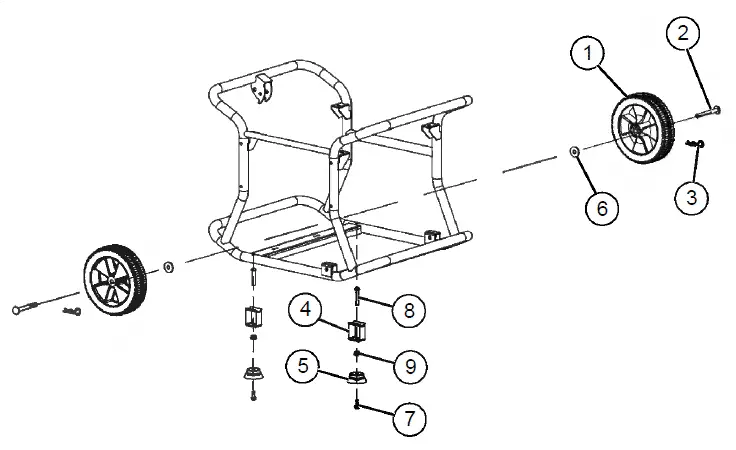
CX5500
Install wheels as follows:
- Slide axle pin (3) through wheel (1), M12 x 4mm flat washer (7), and frame.
- Install M12 x 4mm flat washer (7) and insert cotter pin (4) through axle (3). Bend tabs (of cotter pins) outward to lock into place.
Install frame foot assembly as follows:
- Slide M8 flat washer (9), rubber foot (6), foot spacer (5) onto M8 x 80 bolt (10).
- Align through holes in frame rail and secure with M8 nyloc nut (12). Install handle as follows:
- Slide M8 x 50 bolt (10) through handle bracket and handle (2). Secure with M8 nyloc nut (12).

Add Engine Oil
CAUTION: Engine damage. Verify proper type and quantity of engine oil prior to starting engine. Failure to do so could result in engine damage.
- Place generator on a level surface.
- Verify oil fill area is clean.
- Remove oil fill cap and wipe dipstick clean.
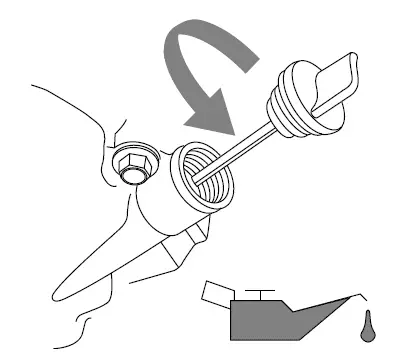
4. Add recommended engine oil. Climate determines proper engine oil viscosity See chart to select correct viscosity.
NOTE: Use petroleum based oil (supplied) for engine break-in before using synthetic oil.
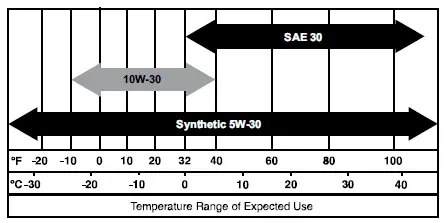
NOTE: Some units have more than one oil fill location. It is only necessary to use one oil fill point.
5. Thread dipstick into oil filler neck. Oil level is checked with dipstick fully installed.
6. See Figure 2-13. Remove dipstick and verify oil level is within safe operating range.

Fuel
DANGER : Explosion and Fire. Fuel and vapors are extremely flammable and explosive. Add fuel in a well ventilated area. Keep fire and spark away. Failure to do so will result in death or serious injury
DANGER: Do not overfill fuel tank. Fill to 1/2 in. of top of tank to allow for fuel expansion. Overfilling may cause fuel to spill onto engine causing fire or explosion, which will result in death or serious injury.
Fuel requirements are as follows:
- Clean, fresh, unleaded gasoline.
- Minimum rating of 87 octane/87 AKI (91 RON).
- Up to 10% ethanol (gasohol) is acceptable (where available; non-ethanol-premium fuel is recommended).
- DO NOT use E85.
- DO NOT use a gas oil mix.
- DO NOT modify engine to run on alternate fuels. Stabilize fuel prior to storage.
- Verify unit is OFF and cooled for a minimum of two minutes prior to fueling.
- Place unit on level ground in a well ventilated area.
- Clean area around fuel cap and remove cap slowly.
- Slowly add recommended fuel. Do not fill above red fuel indicator (A). See Figure 2- 14.
- Install fuel cap.

NOTE: Allow spilled fuel to evaporate before starting unit.
IMPORTANT NOTE: It is important to prevent gum deposits from forming in fuel system parts such as the carburetor, fuel hose or tank during storage. Alcoholblended fuels (called gasohol, ethanol or methanol) can attract moisture, which leads to separation and formation of acids during storage. Acidic gas can damage the fuel system of an engine while in storage. To avoid engine problems, the fuel system should be emptied before storage of 30 days or longer. See the Storage section. Never use engine or carburetor cleaner products in the fuel tank as permanent damage may occur.
Section-3. Operation
Operation and Use Questions
Call Powermate customer service at 1-800- 445-1805 with questions or concerns about equipment operation and maintenance.
Before Starting Engine
- Verify engine oil level is correct.
- Verify fuel level is correct.
- Verify unit is secure on level ground, with proper clearance and is in a well ventilated area.
Prepare Generator for Use
DANGER: Asphyxiation. Running engines produce carbon monoxide, a colorless, odorless, poisonous gas. Carbon monoxide, if not avoided, will result in death or serious injury.
DANGER : The exhaust system must be properly maintained. Do not alter or modify the exhaust system as to render it unsafe or make it noncompliant with local codes and/or standards. Failure to do so will result in death or serious injury.
WARNING : Risk of fire. Do not use generator without spark arrestor installed. Failure to do so could result in death or serious injury.
WARNING: Asphyxiation. Always use a battery operated carbon monoxide alarm indoors and installed according to the manufacturer’s instructions. Failure to do so could result in death or serious injury.
WARNING :Risk of Fire. Hot surfaces could ignite combustibles, resulting in fire. Fire could result in death or serious injury.
WARNING :Hot Surfaces. When operating machine, do not touch hot surfaces. Keep machine away from combustibles during use. Hot surfaces could result in severe burns or fire.
CAUTION : Equipment and property damage. Disconnect electrical loads prior to starting or stopping unit. Failure to do so could result in equipment and property damage.
Grounding the Generator When In Use
The generator is equipped with a terminal for the connection of a grounding electrode system. Article 250.34 (A) does not require the frame of the generator to be connected to a grounding electrode system when the generator only supplies power to cord and plug connected equipment through the receptacles on
the generator.
When the generator supplies power to a 3 pole manual transfer switch or distribution panel boards for temporary power, a grounding electrode system shall be installed and connected to the grounding electrode terminal on the generator. See NEC 250.30, 250.34 and 250.52 for clarification. See Figure 3-1. • Neutral Bonded to Frame
Special Requirements
Review all Federal or State Occupational Safety and Health Administration (OSHA) regulations, local codes, or ordinances that apply to the intended use of the generator. Consult a qualified electrician, electrical inspector, or the local agency having jurisdiction:
- In some areas, generators are required to be registered with local utility companies.
- If the generator is used at a construction site, there may be additional regulations which must be observed.
Connecting the Generator to a Building Electrical System
When connecting directly to a building electrical system, it is recommended that a manual transfer switch be used. Connections for a portable generator to a building electrical system must be made by a qualified electrician and in strict compliance with all national and local electrical codes and laws.
Know Generator Limits
Overloading a generator can result in damage to the generator and connected electrical devices. Observe the following to prevent overload:
- Add up the total wattage of all electrical devices to be connected at one time. This total should NOT be greater than the generator’s wattage capacity.
- The rated wattage of lights can be taken from light bulbs. The rated wattage of tools, appliances, and motors can be found on a data label or decal affixed to the device.
- If the appliance, tool, or motor does not give wattage, multiply volts times ampere rating to determine watts (volts x amps = watts).
- Some electric motors, such as induction types, require about three times more watts of power for starting than for running. This surge of power lasts only a few seconds when starting such motors. Make sure to allow for high starting wattage when selecting electrical devices to connect to the generator:
- Figure the watts needed to start the largest motor.
- Add to that figure the running watts of all other connected loads. The Wattage Reference Guide is provided to assist in determining how many items the generator can operate at one time.
NOTE: All figures are approximate. See data label on appliance for wattage requirements.
Table 3. Wattage Reference Guide

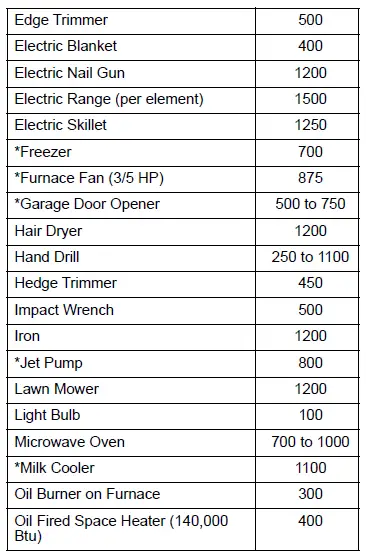
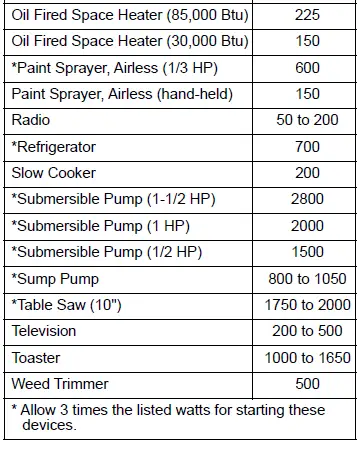
Transporting/Tipping of the Unit
Do not operate, store or transport the unit at an angle greater than 15 degrees.
Starting Pull Start Engines
WARNING : Recoil Hazard. Recoil could retract unexpectedly. Kickback could result in death or serious injury.
CAUTION : Equipment and property damage. Disconnect electrical loads prior to starting or stopping unit. Failure to do so could result in equipment and property damage.
- Unplug all electrical loads from the unit’s receptacles before starting engine.
- Place generator on a level surface.
- See Figure 3-2. Open the fuel shut-off valve (A).
- Turn engine ON/OFF switch (B) to ON. See Figure 3-2.
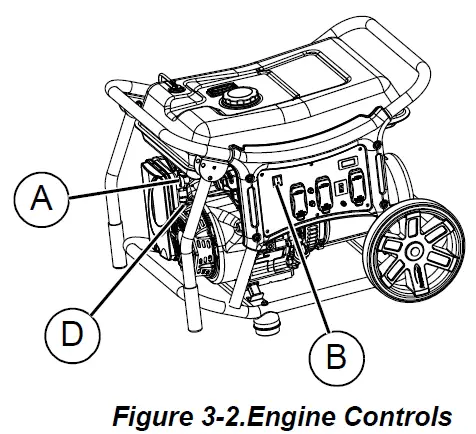
5. Slide engine choke (C) to Full CHOKE position (left). See Figure 3-3.
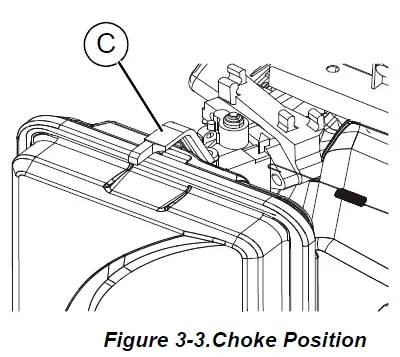
6. See Figure 3-2. Firmly grasp recoil handle (D) and pull slowly until increased resistance is felt. Pull rapidly up and away.
7. When engine starts, move choke lever to 1/2 CHOKE position until engine runs smoothly, then fully into ON position. If engine falters, move choke back to 1/2- CHOKE position until engine runs smoothly, then to ON position.
NOTE: If engine fires, but does not continue to run, move choke lever to Full CHOKE and repeat starting instructions.
IMPORTANT NOTE: Do not overload generator or individual panel receptacles. These outlets are overload protected with Pushto reset circuit breakers. If amperage rating of any circuit breaker is exceeded, that breaker opens and electrical output to that receptacle is lost. Read Know Generator Limits carefully.
Generator Shut Down
Equipment and property damage. Disconnect electrical loads prior to starting or stopping unit. Failure to do so could result in equipment and property damage.
- Shut off all loads and unplug electrical
loads from generator panel receptacles. - Let engine run at no-load for several minutes to stabilize internal temperatures of engine and generator.
- Move ON/OFF switch to OFF.
- Close fuel valve.
NOTE: Under normal conditions, close fuel valve and allow generator to run carburetor bowl out of fuel. For emergencies, switch to OFF
Low Oil Level Shutdown System
The engine is equipped with a low oil level sensor that shuts down the engine automatically when the oil level drops below a specified level. The engine will not run until the oil has been filled to the proper level. If the engine shuts down and there is sufficient fuel, check engine oil level.
Section-4. Maintenance and Troubleshooting
Maintenance
Regular maintenance will improve performance and extend engine/equipment life. The manufacturer recommends that all maintenance work be performed by an Independent Authorized Service Dealer (IASD). Regular maintenance, replacement or repair of the emissions control devices and systems may be performed by any repair shop or person of the owner’s choosing. However, to obtain emissions control warranty service free of charge, the work must be performed by an IASD. See the emissions warranty.
NOTE: Call Powermate customer service at 1- 800-445-1805 with questions about component replacement.
Maintenance Schedule
Follow maintenance schedule intervals, whichever occurs first according to use.
NOTE: Adverse conditions will require more frequent service.
NOTE: All required service and adjustments should be each season as detailed in the following chart.

Preventive Maintenance
Dirt or debris can cause improper operation and equipment damage. Clean generator daily or before each use. Keep area around and behind muffler free from combustible debris. Inspect all cooling air openings on generator.
WARNING : Do not insert any object through the air cooling slots. Generator can start at any time and could result in death, serious injury, and unit damage.
- Use a damp cloth to wipe exterior surfaces clean.
- Use a soft bristle brush to loosen caked on dirt, oil, etc.
- Use a vacuum to pick up loose dirt and debris.
- Low pressure air (not to exceed 25 psi) may be used to blow away dirt. Inspect cooling air slots and openings on generator. These openings must be kept clean and unobstructed.
NOTE: DO NOT use a garden hose to clean generator. Water can enter engine fuel system and cause problems. If water enters generator through cooling air slots, some water will be retained in voids and crevices of rotor and stator winding insulation. Water and dirt buildup on generator internal windings will decrease insulation resistance of windings.
Engine Maintenance
WARNING : Accidental start-up. Disconnect spark plug wires when working on unit. Failure to do so could result in death or serious injury
Engine Oil Recommendations :
To maintain the product warranty, the engine oil should be serviced in accordance with the recommendations of this manual. For your convenience, maintenance kits designed and intended for use on this product are available from the manufacturer that include engine oil, oil filter, air filter, spark plug(s), a shop towel and funnel. These kits can be obtained from an Independent Authorized Service Dealer (IASD).

Inspect Engine Oil Level
WARNING: Risk of burns. Allow engine to cool before draining oil or coolant. Failure to do so could result in death or serious injury.
Inspect engine oil level prior to each use, or every 8 hours of operation.
- Place generator on a level surface.
- Clean area around oil fill.
- See Figure 4-1. Remove oil fill cap and wipe dipstick clean.
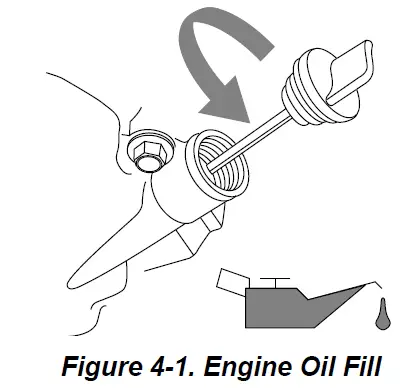
4. Screw dipstick into filler neck. Remove dipstick and verify oil level is within safe operating range. See Figure 4-2.
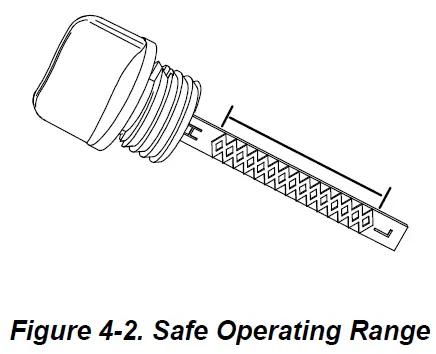
5. Add recommended engine oil as necessary.
6. Install oil fill cap and hand-tighten. NOTE: Some units have more than one oil fill location. It is only necessary to use one oil fill point.
Change Engine Oil
WARNING: Accidental start-up. Disconnect spark plug wires when working on unit. Failure to do so could result in death or serious injury.
When using generator under extreme, dirty, dusty conditions, or in extremely hot weather, change oil more frequently.
NOTE: Don’t pollute. Conserve resources. Return used oil to collection centers. Change oil while engine is still warm from running, as follows:
- Place generator on a level surface.
- Disconnect the spark plug wire from the spark plug and place the wire where it cannot contact spark plug.
- Clean area around oil fill, and oil drain plug.
- Remove oil fill cap.
- Remove oil drain plug and drain oil completely into a suitable container.
- Install oil drain plug and tighten securely.
- Slowly pour oil into oil fill opening until oil level is within safe operating range. DO NOT overfill.
- Install oil fill cap, and hand-tighten.
- Wipe up any spilled oil.
- Properly dispose of oil in accordance with all applicable regulations.
Air Filter
Engine will not run properly and may be damaged if run with a dirty air filter. Service air filter more frequently in dirty or dusty conditions. To service air filter:
- See Figure 4-3. Turn knob (A) and remove air filter cover.
- Wash in soapy water. Squeeze filter dry in clean cloth (DO NOT TWIST).
- Clean air filter cover before re-installing it.
NOTE: To order a new air filter, contact the nearest authorized service center at 1-888- 436-3722
Service Spark Plug
To service spark plug:
- Clean area around spark plug.
- Remove and inspect spark plug.
- Inspect electrode gap with wire feeler gauge and reset spark plug gap to 0.028- 0.031 in (0.7-0.8 mm). See Figure 4-4.
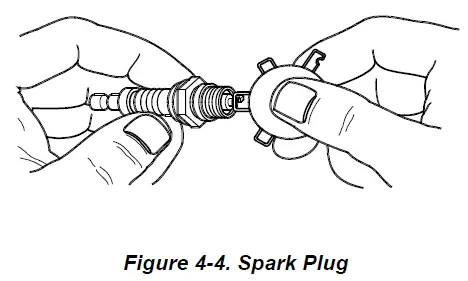
NOTE: Replace spark plug if electrodes are pitted, burned or porcelain is cracked. Use ONLY recommended replacement plug. See Specifications.
4. Install spark plug finger tight, and tighten an additional 3/8 to 1/2 turn using spark plug wrench
Inspect Muffler and Spark Arrestor
NOTE: It is a violation of California Public Resource Code, Section 4442, to use or operate the engine on any forest-covered, brushcovered, or grass-covered land unless the exhaust system is equipped with a spark arrestor, as defined in Section 4442, maintained in effective working order. Other states or federal jurisdictions may have similar laws. Contact original equipment manufacturer, retailer, or dealer to obtain a spark arrestor designed for exhaust system installed on this engine.
NOTE: Use ONLY original equipment replacement parts. Inspect muffler for cracks, corrosion, or other damage. Remove spark arrestor, if equipped, inspect for damage or carbon blockage. Replace parts as required.
Inspect Spark Arrestor Screen (CARB models)
WARNING : Hot Surfaces. When operating machine, do not touch hot surfaces. Keep machine away from combustibles during use. Hot surfaces could result in severe burns or fire.
- See Figure 4-5. Loosen screw and remove retainer clamp (A) and retainer (B).
- Remove retainer screw (C) from muffler outlet tube.
- Remove screen (D) and replace if torn, perforated or otherwise damaged. If screen is not damaged, clean with commercial solvent.
- Replace screen and retainer, secure with screw.
- Install clamp.
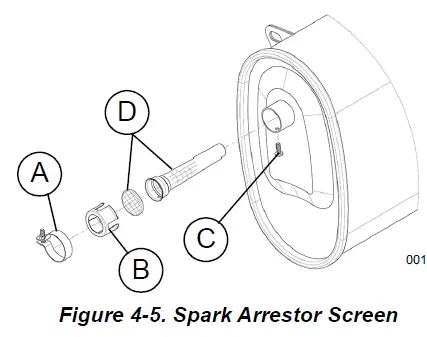
Valve Clearance
IMPORTANT NOTE: If uncomfortable about doing this procedure, or the proper tools are not available, take generator to the nearest service center to have valve clearance adjusted. Check valve clearance after the first fifty-hours of operation. Adjust as necessary.
- Intake – 0.1mm ± 0.02mm (cold), (0.004” ± 0.001” inches)
- Exhaust – 0.15mm ± 0.02mm (cold), (0.006” ± 0.001” inches)
Storage
General
DANGER: Explosion and Fire. Fuel and vapors are extremely flammable and explosive. Store fuel in a well ventilated area. Keep fire and spark away. Failure to do so will result in death or serious injury.
WARNING : Risk of Fire. Verify machine has properly cooled before installing cover and storing machine. Hot surfaces could result in fire.
It is recommended to start and run the generator for 30 minutes, every 30 days. If this is not possible, refer to the following list to prepare unit for storage.
- DO NOT place a storage cover on a hot generator. Allow unit to cool to room temperature before storage.
- DO NOT store fuel from one season to another unless properly treated.
- Replace fuel container if rust is present. Rust in fuel will cause fuel system problems.
- Cover unit with a suitable protective, moisture resistant cover.
- Store unit in a clean and dry area.
- Always store generator and fuel away from heat and ignition sources.
Prepare Fuel System for Storage
Fuel stored over 30 days can go bad and damage fuel system components. Keep fuel fresh, use fuel stabilizer. If fuel stabilizer is added to fuel system, prepare and run engine for long term storage. Run engine for 10-15 minutes to circulate stabilizer throughout fuel system. Adequately prepared fuel can be stored up to 24 months. NOTE: If fuel has not been treated with fuel stabilizer, it must be drained into an approved container. Run engine until it stops from lack of fuel. Use of fuel stabilizer in fuel storage container is recommended to keep fuel fresh.
- Change engine oil.
- Remove spark plug.
- Pour tablespoon (5-10cc) of clean engine oil or spray a suitable fogging agent into cylinder.
WARNING : Vision Loss. Eye protection is required to avoid spray from spark plug hole when cranking engine. Failure to do so could result in vision loss.
4. Pull starter recoil several times to distribute oil in cylinder.
5. Install spark plug.
6. Pull recoil slowly until resistance is felt. This will close valves so moisture cannot enter engine cylinder. Gently release recoil.
Change Oil
Change engine oil before storage.
Troubleshooting
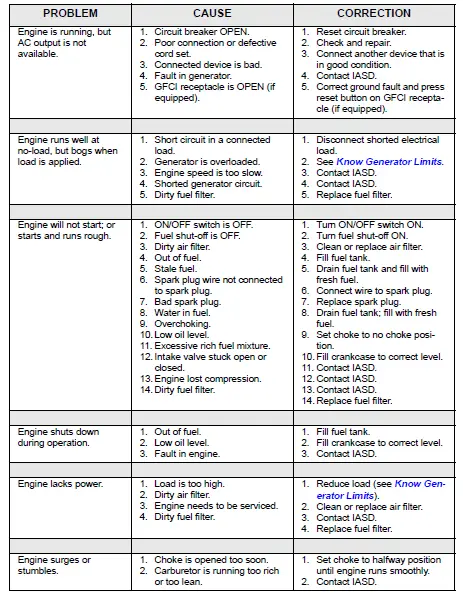
DOWNLOAD RESOURCES
Questions about your Manual? Post in the comments!
FAQ’S
The engine will be running when the control switch is in the RUN position. The control panel will show a green light when the generator is running.
The engine will be running when the control switch is in the ON position. The control panel will show a red light when the generator is charging.
Your generator uses gasoline as a fuel source.
Slide the choke lever to the start position. If the engine is already high place the choke lever in the run. Position turn the engine switch to the on. Position.
Overloading. In the case of overloading, most generators are programmed to shut down. This feature, home to newer models, saves your appliances from getting stressed when the system is being overloaded. A simple solution to this would be to reduce the load of the generator and to restart it.
You want to want to crack the dipstick. So it has plenty of air undo this little screw right here. And then all come out into your little jug. And then make sure you’re always ready to tap.
Plug in a light, turn on the generator breaker or switch and start the motor. Connect the battery +12 volts (red cable) to the red wire on the terminals you removed for three seconds. Remove your wires and replace the plug. The generator should now be producing power again.
One of the most common reasons a generator will not start is due to a battery failure. Often this could be caused by a loose connection or a sulfation build-up (a build-up of lead sulphate crystals on the plates of lead-acid batteries).
You should replace the oil filter also if your generator has one. Some opt not to; instead, they drain the generators old oil to save costs. Doing so means running new oil via an old dirty filter and is not the best idea.
Reset Breaker for Power Tech Generators. Reset breakers are located on the control box of your generator along with the main on/off switch and main breakers. Reset breakers protect the circuit from surges. When your generator experiences a surge, these breakers need to be pushed in to be reset.
Choke Position Open for Too Long (Portable Generators)
After a few minutes, change it to half, then after a few more minutes change it to run. Generators can shut off after a few minutes of running if the choke is left in the full choke position for too long.
When too many appliances are connected to a generator, more electricity is flowing through the circuit than it can handle, causing it to overload and trip the breaker to protect your devices.
VIDEO
www://powermate.com/
